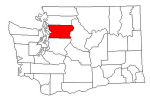Snohomish County, formed on January 14, 1861, was originally part of Island County. It covers 2,098 square miles, ranging from the Cascade Mountains to Puget Sound. It is bordered by Skagit County to the north, King County to the south and Chelan County to the east. Forest constitutes 68 percent of the county's land, and Mt. Baker National Forest and 10,436-foot Glacier Peak lie within its boundaries. Two major river systems flow through the land: the Stillaguamish River, with its north and south forks, and the Snohomish River, formed from the Skykomish and Snoqualmie rivers. For thousands of years the Snohomish and related tribes inhabited the area that presently comprises Snohomish County, Hat, Whidbey, and Camano islands. Following the 1855 Point Elliott Treaty, most of the Snohomish were relocated to a reservation established at Tulalip. Early white settlers arrived to take advantage of the area's agricultural, logging, mining, and industrial potential. By the 1920s, logging, lumbering, and agriculture dominated the economy, but in recent years, the largest county employers are aerospace, technology, service industries, tourism, and the building trades. Snohomish County is presently one of the fastest growing counties in the region with a population of 671,800 (2006). Everett is its largest city and the county seat.
First Peoples
The Snohomish Tribe comprised the largest Native American population in this county area. They lived along the shores of Puget Sound from Warm Beach to Richmond Beach and along the Snohomish River to Monroe. The Stillaguamish (Stoluck-wha-mish) lived along both north and south forks of the Stillaguamish River, near present-day Stanwood; the Skykomish (Skai-wha-mish), along the Skykomish River, now Sultan and north of Index; the Sauk-Suiattle (Sak-ku-me hu) in the area that is now Darrington; and the Snoqualmie (Suqualmoo) near present-day Duvall and Monroe. The tribes spoke Lushootseed, most using the northern dialect, and followed the traditional cycle of fishing, hunting and gathering.
Hibulb (also hibulob or Hebolb) was their principle village. Situated on the northern tip of today’s Everett peninsula, Hebolb was oriented to both the Snohomish River and Port Gardner Bay. A cedar stockade defended villagers against warring tribes.
European and American Exploration
British Captain George Vancouver (1757-1798) landed on the beach south of Hebolb on June 4, 1792, claiming the Puget Sound region for King George III and naming nearby locations including Puget Sound, Port Gardner Bay, and Port Susan Bay. Vancouver did not note the Snohomish River, but Hudson’s Bay records list it in 1824 as “Sinnahamis.” The river was charted as “Tuxpam” by the U.S. government expedition of Charles Wilkes (1798-1877) in 1841. The present form “Snohomish” dates from the U.S. Coastal Survey of 1854.
On January 22, 1855, Governor Isaac Stevens (1818-1862) and 81 tribal leaders met at Point Elliott (now Mukilteo) to sign a treaty between regional tribes and the U.S. government. Snoqualmie Chief Patkanim (ca.1808-1858) represented the Snohomish, Snoqualmie, and Skykomish bands, signing away their lands in exchange for cash, hunting, and fishing rights, and a reservation established at Tulalip. French Catholic priest, Father Eugene Casimir Chirouse (1821-1892), was assigned to Tulalip in 1856, establishing St. Anne’s mission and a government boarding school.
Early White Settlement
The Tulalip Bay settlement of 1853 has been described as the birthplace of Snohomish County. Whidbey Island pioneer John Gould (1823-1900), Hudson’s Bay trapper Peter Goutre (1804-1875), and Jehial Hall staked claims along Tulalip Bay (now part of the Tulalip Reservation). Charles C. Phillips (1824-1867), who ran a canoe mail service, and Seattle pioneer Dr. Wesley Cherry (?-1854) joined Gould in creating the Tulalip Mill Company and began operating a waterpowered sawmill. Hall granted water, land, and timber access to his land in exchange for a partnership in the mill. The venture was short-lived: Cherry was killed by Indians the following year, and the Tulalip Reservation was formed at this location.
Hoping to control Indian unrest following the treaty, Company I, First Regiment of Washington Territory Volunteers, under Col. Isaac Ebey (1818-1857) was dispatched to build a fort on the Snohomish River. The men boarded the schooner Trask in November 1855 and were towed by the steamer Traveler to a small island at the head of Ebey Slough, about a mile southeast of Lowell. Here the men erected a crude cedar-log building and christened it “Fort Ebey.” They withdrew from the site early in 1856, following an uneventful winter.
In 1860 Port Townsend federal customs officer Morris H. Frost (1804-1882) built a store and saloon at Mukilteo, and convinced Jacob Fowler (1837-1892) from Ebey’s Landing to join him as a business partner. Pioneer Emory C. Ferguson (1833-1911) scouted opportunities along the Snohomish River and eventually settled at what was to become Snohomish City. Ferguson moved a prefabricated house to this location and became a permanent resident in 1860. His small home still stands today.
As the population grew, local settlers petitioned the territorial legislature to develop a separate county, and Snohomish County, originally part of Island County, was formed on January 14, 1861. Mukilteo became the temporary county seat until a July election moved it to Snohomish.
Rich farmland and easy water access attracted homesteaders, and settlements also began at Lowell, Monroe, Stanwood, and Edmonds. As Washington Statehood neared, Snohomish City was the county’s cultural, financial, and political center. The small community now included a school, a library, a science collection, and even an Athenaeum Society. In 1876, journalist Eldridge Morse began publishing a well-respected territorial newspaper called The Northern Star.
During Washington's territorial years, the peninsula that would become Everett was mostly logged by companies drawn to its old-growth trees and the proximity to mills at Port Gamble and Utsaladdy. About a dozen homesteaders and squatters chose this location as well.
In 1862 reclusive Dennis Brigham (1807-1887) homesteaded on the bayside. Erskine D. Kromer (1836-1885) came to string telegraph lines, stayed, took a homestead claim, married a Coast Salish woman, and began raising a family. That same year, Jacob (1837-1916) and David Livingston (1830-1913) platted a development on the bayside (present-day Harborview Park, Everett) and named it Western New York. While the Livingston brothers sold only a few lots, they built and operated the county’s first steam-powered sawmill. The following year, Leander Taylor and Clarence Bagley opened a store at the Hebolb site and built the sloop Rebecca. By the 1870s, Mukilteo boasted having the Eagle Brewery as well as the first fish cannery in Washington Territory.
The Railroad, Gold Fever, and Everett
Snohomish County grew, as did all the Pacific Northwest, with the arrival of the railroad. On July 4, 1889, Joseph Pearsall struck gold and staked a claim at Monte Cristo. This drew prospectors to the area and helped solidify plans for the development of an industrial city at Port Gardner Bay.
Hoping that the Great Northern Railroad would first touch tidewater here, Tacoma lumberman Henry Hewitt Jr. (1840-1918) convinced East Coast investors, including John D. Rockefeller (1839-1937), to invest in the city that was to become Everett. With Rockefeller money in the mix, other speculators soon joined, convinced that a Rockefeller venture could not fail. Thus the Everett Land Company was formed, and work crews began to clear land in the summer of 1891.
The Everett economy was developed around four major industries: a nailworks, a smelter, a whaleback bargeworks, and a paper mill at Lowell. But the silver panic of 1893 halted the boom, and Rockefeller sold his interests. When the national economy improved in 1899, the Everett Land Company holdings were transferred to the Everett Improvement Company, funded by money from railroad tycoon James J. Hill (1838-1916). Soon Everett had many lumber and shingle mills, iron works, shipbuilding establishments, a brewery, a flour mill, and a cannery on the waterfront. The Improvement Company also built city parks and a theater.
A bitter controversy over location of the county seat ensued between the established town of Snohomish and the upstart city of Everett. This controversy raged from 1894 to 1897 through public votes, appeals, and court rulings. Both sides claimed voting irregularities. Everett became the county seat in 1897.
Labor, Management, and the Progressives
By 1910 it was estimated that a fifth of Everett’s population was employed in the mills, where working conditions were dangerous and hours long. Railroading and logging held equal dangers. Trades unions gained an early, solid base in Everett. When the first issue of the Labor Journal was published in Everett on February 26, 1903, the newspaper listed 31 trades unions with a combined membership of 2,500 in a city whose total population was about 10,000. Cooks and Waiters, Laundry Workers, and Cigarmakers unions included women in their ranks.
Management and timber bosses were strong union opponents, and Snohomish County became fertile ground for arguing labor issues. Soapbox speakers were common, particularly in Everett, where there were many Progressives, even Socialists. State Senator John Campbell (1880-1924), a Progressive from Everett and a Labor Journal manager, passed an 8-Hour Work Day bill for Washington women in 1911. Journalist Anna Agnes Maley (1872-1918) arrived in Everett to edit the Socialist newspaper, the Commonwealth, and stayed long enough to run for governor of Washington State in 1912.
The Industrial Workers of the World (IWW or Wobblies) gained strong support in Snohomish County lumber camps. As one old-time logger expressed it in a 1974 interview, “You just about had to join” (Wardell). In Everett, however, one joined at peril. IWW members were blacklisted, unable to find work in the mills. When Everett shingle weavers went on strike over wages, the Wobblies came in support. Events culminated November 5, 1916, in the Everett Massacre, a labor confrontation between the IWW and county lawmen that left two deputies and at least five Wobblies dead, with dozens more wounded.
World War I to 1929
World War I dashed the hopes of radicals, and Snohomish County solidly backed the war effort. The predominant economy now was lumbering, with 130 lumber and shingle mills including Weyerhaeuser, Clough-Hartley, Jamison, Index-Galena, Sultan Railway and Timber, the Rucker Brothers Mill, Puget Mill Company (Pope and Talbot), and Merrill & Ring Logging. The 1923 Tokyo earthquake spurred a lumber boom in the Pacific Northwest, bringing the region out of recession and fueling development that lasted until the stock market crash.
Snohomish County’s agricultural base also grew with the addition of dairies and egg farms. Alderwood Manor was created when the Puget Mill Company sold five-acre tracts and built a demonstration egg and poultry farm. The Arlington Condensery began in 1921 and operated until the late 1950s.
Snohomish County's Great Depression
During the hard times of the 1930s, government reports listed Snohomish County as one of the state’s neediest counties. Its lumbering economy tumbled. Mills closed and restarted, only to close again. Snohomish County was quick to line up for government aid issued through the National Industrial Recovery Act (NRA), the Works Progress Administration (WPA), and the Civilian Conservation Corp (CCC).
Major projects included expansion of Everett’s Forest Park, a new Everett Public Library, the Everett Civic Auditorium, and a county airport, the beginnings of Paine Field. CCC workers built major camps at Darrington, Sultan, and Index; the Verlot office building; guard stations at Index, Barlow Pass, Bedal, and Suiattle River; and created the Monte Cristo Ranger District.
Washington Politicians
The 1920s and 1930s saw the rise of women politicians, including Alice Kerr (1858-1949) who became mayor of Edmonds in December 1925, three months before Bertha Knight Landes (1868-1943) took office as Seattle mayor.
Republican mill owner Roland H. Hartley (1864-1951) of Everett became governor in 1924 and served two troubled terms in office. Everett’s Monrad C. Wallgren (1891-1961) was elected to the U.S. House of Representatives in 1932. Running as a Democrat New Dealer, Wallgren was re-elected to three more terms in the House, then to one term as a U.S. Senator in 1940, and then served as Washington state’s 13th Governor. Perhaps the most influential politician from Snohomish County was Democrat Henry M. Jackson (1912–1983) of Everett whose congressional career ran from 1940 to his death in 1983.
World War II and Postwar Growth
Following the bombing of Pearl Harbor, Everett citizens guarded their waterfront, at first watching in shifts from atop the city’s Medical Dental building. The Everett Pacific Shipbuilding and Drydock Company, operated by Pacific Car and Foundry of Seattle, began wartime production on the Everett waterfront in 1942. Everett Marine Ways, the Carl E. Edlund Shipyard, and the Stanwood Shipyard contracted to build ships for the Navy as well. The Arlington airport became a Navy base, providing Grumman Fighters for service in the Pacific. Boeing Aircraft Company operated two airplane assembly plants in Everett, employing mostly women. In 1943, Paine Field was converted to a military base.
Post-World War II growth in the Pacific Northwest quickly connected rural areas and small towns. Highway construction linked Stanwood, Snohomish, and Monroe with Everett, Seattle, Tacoma, and Bellingham. And towns such as Edmonds, Brier, Woodway, Mountlake Terrace, and Lynnwood expanded, smothering what remained of Meadowdale and Alderwood Manor. Bothell’s boundaries moved north from King County. Confined by its peninsula, Everett expanded southward. The Everett Herald began its South County Bureau in May 1954. Lumbering still dominated the economy, but now loggers used portable sawmills and trucks to easily transport logs for milling.
The Boeing Presence
In 1967 Boeing began building the 747 plant near Everett’s Paine Field, thus initiating rapid population growth in the county. The small town of Mukilteo experienced immediate changes when a steep rail line was built through Japanese Gulch from the Great Northern tracks in old-town Mukilteo to the Boeing plant site.
Residents were told that the new industry would be “recession proof,” but Boeing soon suffered in the nationwide hard times that began in 1970. Boeing has continued to have good and bad times, but remains the county’s largest single employer.
Recent Decades
Growth issues have dominated city and county life since the 1970s. Much of the county’s farmland has been sold for real estate, and once-quaint roads have become highways with numbers instead of names. When an Everett Navy homeport was planned in the 1980s, a citizen group formed to oppose these plans. But Weyerhaeuser’s layoff of 300 workers and its announcement to close Everett operations rallied voters to overwhelmingly support Naval Station Everett, which was dedicated in 1994.
Ecologists have been able to preserve important county wetlands and natural habitats, and in 2006 the county website boasts a Snohomish River Estuary that supports 350 kinds of birds, mammals, and plants. A new county program has been put in place to save remaining farmland and open space, and the county government fosters a Snohomish River salmon recovery program to save a dwindling fish population.
In 2006, Snohomish County is one of the fastest-growing communities in the United States. Its economy is a mix of technology, aerospace, service-based business, the building trades and tourism. The county is home to three federally recognized Native American tribes, the Stillaguamish, the Sauk-Seattle, and the Tulalip. The Tulalips (originally the Snohomish, Snoqualmie, and Skykomish bands) have become prosperous from their casino and real-estate ventures. They plan to expand the casino, add more stores, a hotel, and a long-awaited tribal museum.
Boeing is currently riding a
wave of prosperity. Lynnwood is
planning to allow 35-story
buildings, and Snohomish is
struggling to accommodate
necessary growth while keeping its
rural and historic
bed-and-breakfast character.
Everett, its population at 101,100
in 2006, has monumental plans that
include re-zoning for high-density
development in the central
business district and waterfront.
Despite these changes, there is
still a strong rural feeling in
many of Snohomish County’s smaller
towns such as Index, Granite
Falls, Arlington, Verlot, and
Darrington. Visitors don’t need to
travel far to reach some of
Washington state’s most scenic
recreational areas.


















